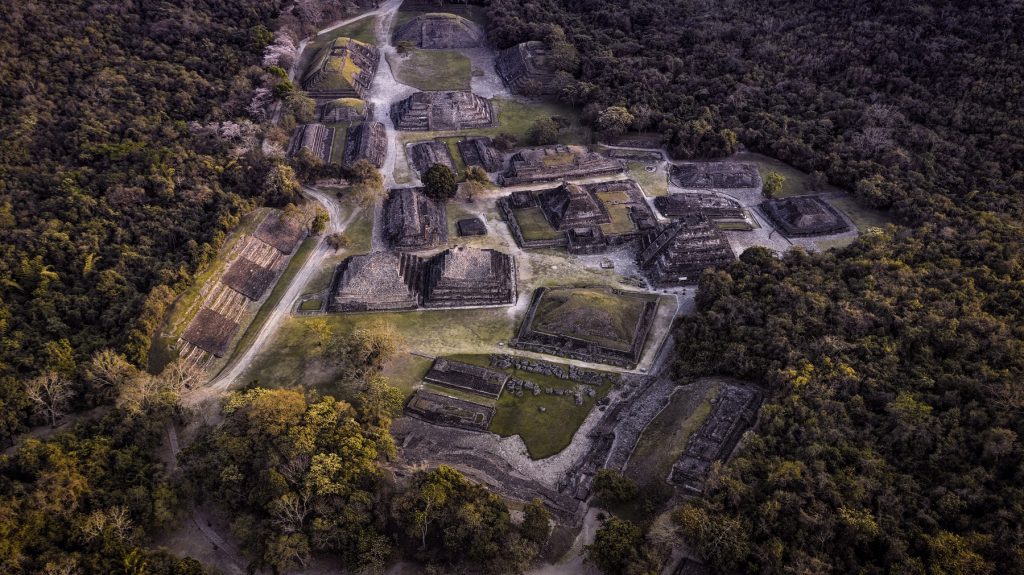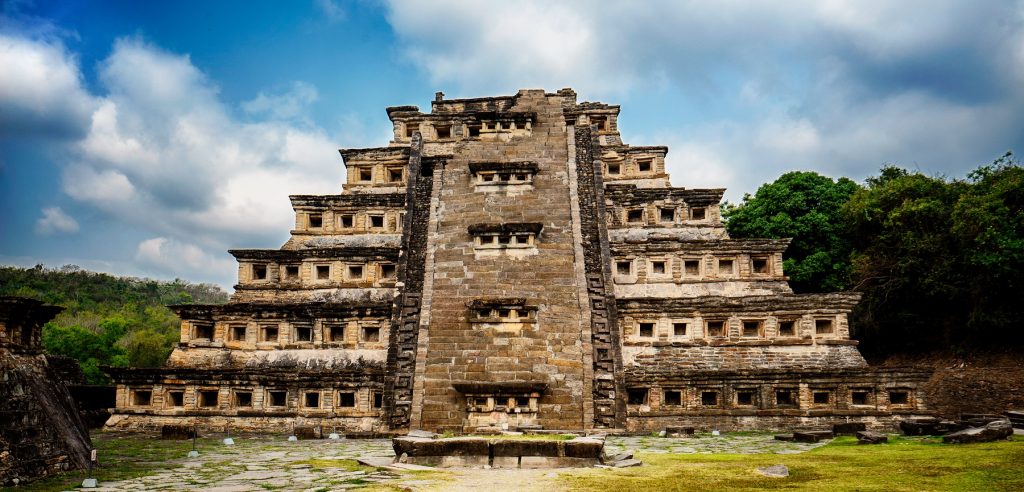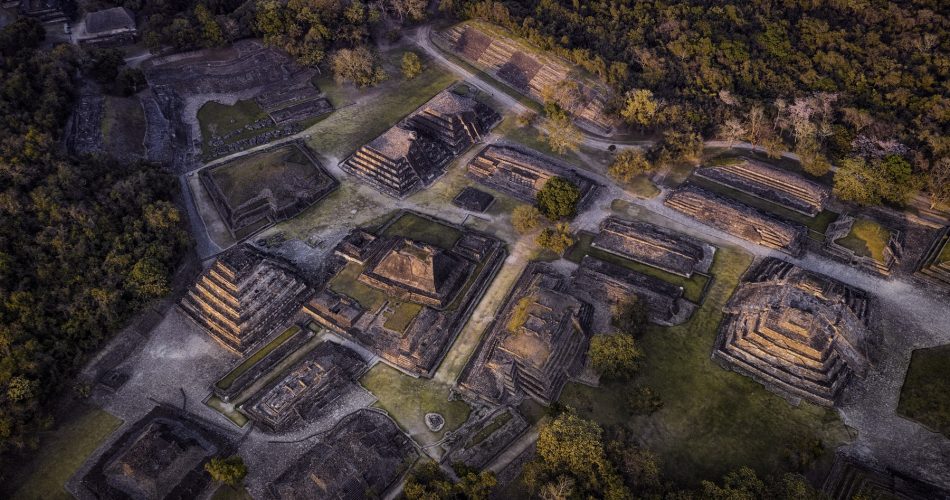- The Pyramid of Niches is one of the most unique pyramids ever built in Central America.
- It features as many as 365 “windows” which are part of one massive calendar made of stone. The pyramid of El Tajin is a Step Pyramid composed of seven superimposed structures. The structure has a height of around 20 meters.
- El Tajin, the city where the pyramid was built, also features as many as 17 ball courts which has led some experts to believe that the city of El Tajin was a kind of “Olympia” in the Americas where prominent sporting events were held.
- The city was eventually conquered by the ancient Aztec Empire.
The ancient city of El Tajin, located in the modern-day state of Veracruz in Mexico, is famous for a pyramid that not many people know about. The ancient site is remarkable for various reasons: it is home to numerous ancient structures, temples, palaces, ball courts, but most importantly a pyramid. Called the pyramid of niches, this structure was built having as many as 365 niches. This architectural feature suggests a deep connection between the pyramid and the solar year.
The ancient pyramid of the niches is unique for a number of reasons. It is made out of seven superimposed platforms like many other pyramids across Mesoamerica. Its architecture suggests it is a step pyramid. It features a staircase on its northern side, used to access its top. But its stepped-pyramid design is not what makes it one of the most unique pyramids in Mesoamerica. That which is located on its exterior makes it an unusual Mesoamerican wonder.
The pyramid’s outer decoration is composed of 365 niches not including those that are hidden under the staircase and including those that divide it into two halves by its central part. They are thought to represent the solar year. Each of the pyramid’s four sides is covered with a stacked row of smaller niches that are made of stone. Each niche is believed to have been part of a kind of astronomical calendar made of stone. The pyramid rises to a height of around 20 meters.
El Tajin, a city of pyramids and mysteries
Much about the ancient city, the empire, and the people who built this unique ancient wonder remains shrouded in mystery. Archaeological survey of the site suggests that the ancient city of El Tajin rose to the power between 800 and 1,200, during a time that coincides with the fall of the Teotihuacani empire, and the rise of the Aztecs.
The city grew to become one of the most important sites in the Mesoamerican northeast, and its cultural influence was felt across the Mexican Gulf, and as far away as the Yucatan peninsula, deep within Maya territory. The city displays both Maya and Oaxacan architectural styles.
The identity of the people behind the design of this unique pyramid city remains one of the many mysteries of Mesoamerican history. The builders of the pyramid city have captivated the imagination and interest of archaeologists for decades. Their marvelous architectural design, their pyramids, and the profound meaning behind each structure has puzzled generations of experts.
And despite years of survey and excavations, most of the history of El Tajin remains shrouded in mystery. Nonetheless, theories suggest that the city and its pyramids were built by the ancestors of the ancient Totonac people who inhabit the region to this date.

The city is believed to have been an important regional power, with an estimated 20,000 people living in its core. The city’s reach extended outwards into parts now covered by the jungle, which suggests the city may have had an even greater population.
The surrounding fertile land was ideal for the cultivation of maize, cacao, vanilla, and tobacco, which provided all the necessary elements for Tajin to quickly prosper. Thanks to its various crops, the city was able to establish and support a prosperous trade center. The inhabitants of El Tajin may have been among the first to cultivate orchids that produce vanilla.
Archeological excavations of the site have revealed that the city was inhabited in the 1st century CE. Since these early traces of habitation, the ancient city is thought to have undergone as many as twelve distinct construction phases leading up to the 12th century CE.
The earliest phases of the history of the city are marked by an evident influence of greater cities such as Teotihuacan. This influence is supported by the discovery of pottery and the city’s architectural elements, most notably El Tajin’s stepped pyramids.
There is evidence that El Tajin’s influence grew at a relatively accelerated pace. The numerous structures on the site are evidence of the city’s development and growth. Its oldest (latest) surviving pyramid can be traced back to around the 6th century CE.
As the city expanded, so did its interest in surrounding regions. Scholars say that around the 7th century CE, El Tajin began conquering smaller settlements that were located nearby, helping establish itself as the dominant kingdom in the area.
Little did they know that just how they conquered their neighbors, so would their neighbors (the mighty Aztecs) eventually conquer them.
Archaeologists believe that during the 8th century CE, the Pyramid of the Niches was completed. The Pyramid was built, like many other similar structures, in various phases over several years, possibly even decades.
The city’s accelerated growth, its abundance of natural resources and strategic position would attract many enemies. The city is believed to have fallen and was abandoned around 1,200 when a massive army of Aztec warriors pillaged and burnt the city. Eventually, the population of El Tajin surrendered to the Aztecs who subjugated not only the inhabitants of El Tajin but also many of its nearby settlements.
Around 1,412, when the Spanish Conquistadors set foot at present-.day Veracruz, the Totonac and Huastec people of the region joined allies with the Spanish, hoping to push out the Aztecs from their land.
The ruins of the ancient city remained hidden from sight until in 1785, colonial authorities stumbled across the ruins of the ancient city and its pyramids after looking for illegal tobacco plantations.
Its importance has remained, but its fame has not increased like that of other sites such as Chichen Itza or Teotihuacan. Despite the site’s vast importance, cultural influence, and rich history, El Tajin and its pyramids remain one of the least explored and visited ancient sites in Mexico.
The Pyramid of Niches

The most prominent pyramid of the city of El Tajin is thought to have been completed in the 8th century CE. It features 365 symmetrically positioned square niches—each of which is 60 centimeters deep. Each of these niches, together with the heavy scroll carvings, create a constantly shifting play of lights and shadows when the monument is struck by sunlight. Archaeologists believe that the pyramid’s niches, and the structure in general, are deeply connected with the solar year.
The pyramid is a step pyramid consisting of seven superimposed structures and rises 20 meters in height. Each of its sides measures 26 meters and a beautifully-decorated stairway leads to a small temple-like structure at its summit.
An Olympia in America?
In addition to its amazing pyramids, plentiful history which helps us better understand a time when the empire of Teotihuacan disappeared and the Aztec empire rose to power, the city of El Tajin can also be considered as a kind of “Olympia” in Mesoamerica.
This is because the city of El Tajin is home to as many as seventeen ball courts, a number which is highly unusual for such a city. This has led some experts to theorize that in the distant past, mayor sporting events took place at El Tajin, which can be compared, in terms of size and impotence, to those at Olympia, halfway around the world in ancient Greece.

